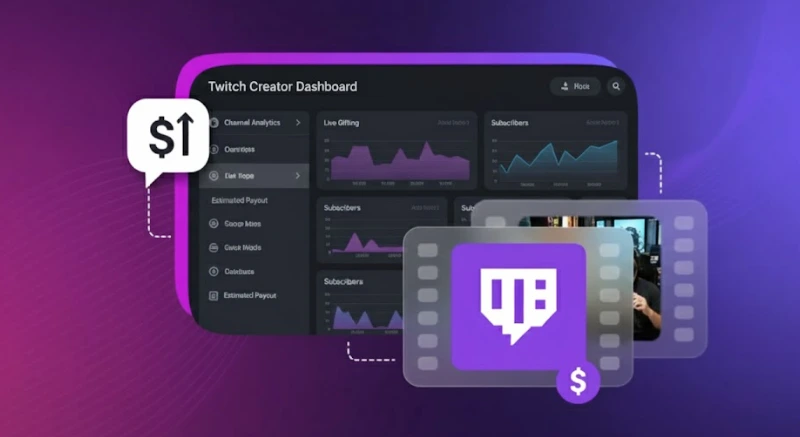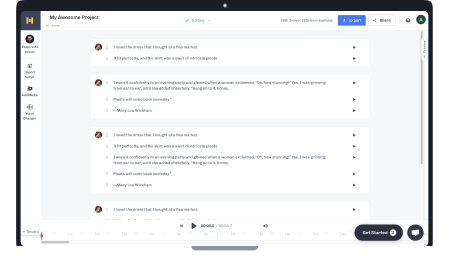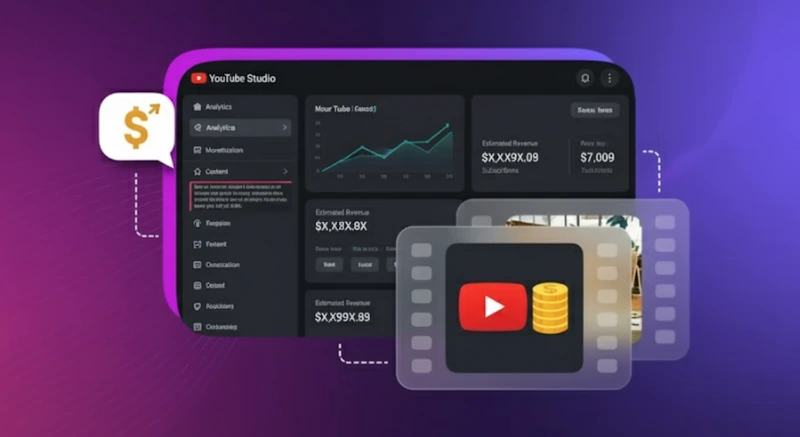How to Make Money on Twitch Fast: Earnings Explained for Creators in 2026

Twitch streamers around the world are investing heavily in their channels to produce quality content for their viewers and grow their channels.
And why not? After all, Twitch is a leading live-streaming platform that allows creators to share gaming, music, art, comedy, and other lifestyle content with their audience in real-time.
Additionally, the platform offers Twitch users various ways to grow their revenue, such as subscriptions, ad revenue, and sponsorships.
While the variety helps make money on Twitch effectively, it can get confusing for new creators on the platform. Many streamers might struggle to understand the channel's monetization policies, failing to maximize their income.
In this article, let's understand the nuances of the streaming platform and learn how to make money on Twitch.
The Three Tiers of Twitch Monetization
1. Twitch Affiliate Program
The Twitch affiliate tier is for entry-level creators who have just started to build a personal brand on the platform via live-streaming. This level gives access to multiple revenue-generation tools like Twitch subscriptions, Twitch Bits, and Twitch ads.
To qualify for this tier, Twitch creators need to gain at least 50 followers, broadcast for at least 500 minutes across seven distinct days, and maintain an average of three concurrent viewers.
This tells Twitch that the creator has the potential to build an established and engaged audience, unlocking the Twitch affiliate program.
The income potential in this tier for many Twitch streamers is often limited, as it is dependent on the size of the channel, which only grows with time. At the same time, this gets the foot through the door as a creator can earn money on Twitch.
2. Twitch Partner Program
The Twitch Partner level is accessible for users with larger and more consistent audiences. To join this tier, streamers need to apply through their Twitch account and earn the approval of the platform.
Then, the professionals managing the Twitch partnership program will check multiple metrics. This includes the number of regular viewers, Twitch community engagement, and content quality.
This increases the revenue potential of Twitch partners through better reach and more profitable revenue splits. Creators with loyal Twitch audiences get access to Twitch's Plus program, which is explained in the next section.
3. Twitch Plus Program
Recently, Twitch streamers who are a part of the affiliate program or the partner program are evaluated through the Plus program monetization framework. This aims to boost the income of users who create Twitch content.
The program is performance-based, where revenue is split between Twitch and the creators based on how many followers consistently join the creator's Twitch streams.
When a content creator on Twitch accumulates 100 Plus points over three consecutive months, they can access a 60/40 split, with Twitch keeping a 40% cut.
When it rises to 300 Plus points over a similar period, Twitch offers a 70/30 split, with 70% going to the creator. Note that the split is applicable to the revenue gained from channel subscriptions and has no upper cap.
Earlier, the creator-centric revenue splits were capped at $100,000 annually, beyond which Twitch enforced a 50/50 split rule. That has been removed so that creators can make extra money on Twitch.
Furthermore, Twitch locks in an account holder's split for a year, even if their viewership dips during the period. This gives more income stability to creators, especially those who stream regularly.
5 Key Revenue Streams on Twitch
1. Subscriptions
Subscriptions are monthly fees paid by a target audience for various perks, which are defined by the creator. Usually, the subscription tiers of a Twitch channel are priced at $4.99, $9.99, and $24.99 per month.
It is slightly different from YouTube channels, where the user has more control over deciding the tier rates.
The perks depend on what the creator is willing to offer. Some provide access to certain live streams, while other Twitch streamers share more exclusive content.
When new streamers join Twitch, they have to abide by the 50/50 split, which can later evolve to 60/40 or 70/30 based on how many viewers they attract.
2. Bits or Cheers
Bits or Cheers are tips for Twitch creators from their viewers. Audiences purchase Bits using real money on Twitch and spend them during live streams to "cheer" the creator up.
Each Twitch Bit is worth $0.01, and the creator receives the net value. Twitch takes the cut at the moment of Bit purchase. Additionally, this is an affiliate or partner-only opportunity, inaccessible to beginners.
It might appear that the value of each Bit is too little, but they can add up over time, which can lead to an unpredictable but meaningful boost in Twitch earnings.
3. Ad Revenue
The ad revenue monetization method helps popular Twitch streamers generate earnings by showing promotional messages during live streams. Twitch's Ad Manager can help creators customize when these ad breaks happen.
For instance, streamers that play video games online might schedule them in between their matches. This increases ad viewership without disrupting the flow of the live stream.
Creators are paid based on the cost per mille (CPM) business model. Typically, affiliates earn a 30% share of the revenue. However, by joining Twitch's Ads Incentive programs and meeting ad-viewership thresholds, the share can go as high as 55%.
Compared to the above two revenue streams, making money on Twitch ads is more volatile. The income depends on advertisers and viewer geography. Other factors include ad frequency and personal brand appeal. Moreover, premium subscribers enjoy an ad-free viewing experience, affecting the net cash flow.
4. Game Sales
Creators playing games that are supported by Twitch can encourage viewers to make purchases. Either they can buy the title or in-game items. The platform keeps a cut, and the gamer earns referral revenue.
This monetization method is accessible to both Affiliates and Partners, depending on the game studio's accessibility criteria.
While selling games can add to a creator's Twitch income, the amount is relatively small compared to the above three categories. Historically, Twitch pays a meager 5% to the streamers.
To put it into perspective, if 1000 viewers make a $20 game purchase, the creator will only make $1000 in gross revenue before fees. In many cases, the conversion, even for experienced gamers on Twitch, is less.
Aspiring gaming content creators can look at it as a way to supplement their income, not as a main source of revenue.
5. Donations and Merch Sales
The final method of Twitch monetization occurs outside of the platform's ecosystem. Creators can set up a third-party donation link via services like PayPal to accept donations from their audience.
Additionally, popular streamers can sell merch through their personal eCommerce platforms to make more money. Merch can include t-shirts or other custom products, like coffee cups or novelties, that can be profitably produced through a print-on-demand business model.
However, this income source can be highly unpredictable. It depends not only on a creator's Twitch profile but also on their presence on other platforms.
A well-established streamer can sell custom merchandise at a higher volume and markup, something new creators who have just started streaming cannot do.
Similarly, the donations are dependent on generosity, community culture, and the nature of the audience. Both male and female streamers may experience significant fluctuations in donations, making this income method unpredictable.
How Much Do Twitch Streamers Make?
1. Small Streamers (5–10 average viewers)
Beginners’ primary source of income on Twitch is subscriptions and donations from supporters. As these creators are new, the revenue from Twitch Bits and sponsorships is usually limited.
Typically, Twitch streamers in this category with 5-10 average viewers per live broadcast can expect about $50-$150 per month.
2. Mid-Tier Streamers (100–500 average viewers)
When the number of viewers reaches a few hundred consistently, the creator can expect a surge in their subscription income, ad revenue, and Bits. Twitch streamers in this category have a few thousand subscribers, which can help them earn about $1k-$5k per month.
3. Large Streamers (1000+ average viewers)
These are established creators who have strong audience bases on Twitch. This earns them consistent viewership in their Twitch live streams that ranges in the thousands. Such entertainers earn about $10k+ per month.
Large streamers take home a bigger paycheck because their popularity attracts sponsorships and donations from super fans. Moreover, they can negotiate a more favorable cut with Twitch to boost their income further.
Factors that Affect Twitch Income
1. Audience Geography
The location of viewers affects ad rates, subscription pricing, and purchasing power.
Advertisers, generally, pay higher CPMs for the US and Western European audiences than for other regions like Asia and Africa. Similarly, Twitch adjusts subscription pricing based on location, meaning some subscriber streams generate less revenue.
2. Viewer Engagement and Brand Appeal
Loyal and interactive audiences are more likely to subscribe, give Bits, make donations, and purchase in-game items or merch. A higher brand appeal can build such an audience quickly and more effectively.
3. Streaming Schedule
Streamers who go live regularly earn revenue that exceeds their peers. Consistent content creation increases the number of average viewers while shaping the audience's habits. Down the line, this fosters loyalty, growing the branded community.
4. Twitch's Policies and Fee Splits
Each social media channel constantly changes its monetization policies, and Twitch is no different. Over the years, the splits and income caps have evolved, which significantly affect how much a creator can make on the live streaming platform.
These policies also determine the partner or affiliate status of a creator and whether they can run ads in their live streams.
Tips to Maximize Earnings on Twitch
It can get overwhelming for new, even experienced, creators on Twitch to build reliable and lucrative revenue streams around the streaming platform. The following tips will help such Twitch streamers navigate the complexities easily and maximize their income:
- Diversify revenue sources: Instead of relying solely on subscriptions, consider investing in additional revenue streams, such as Bits, donations, and ad revenue.
- Build a loyal community, not passing viewers: Fans will join streams more frequently, boosting the account’s visibility and long-term revenue potential.
- Get professional equipment: A good mic, camera, and streaming setup will deliver a better experience to the Twitch audience, earning their loyalty.
- Create content consistently: Host digital events like subathons, challenges, etc., to engage viewers regularly and increase revenue.
- Market in other social platforms: Distribute Twitch content on other platforms like Instagram to attract more viewers.
How Murf AI Helps Creators Boost Twitch Revenue

Murf AI is an industry-leading voice generator and AI dubbing tool that helps Twitch creators grow their reach on other social media channels.
As a streamer, you can leverage this solution to take snippets from your past streams, translate the audio in your cloned AI voice, and create stories for Instagram or post them as standalone YouTube videos.
Localization via human-like audio dubbing with Murf AI is effortless and quick, which allows growing creators like you to attract global audiences. Consequently, you can gain more subscribers, brand sponsorships, ad revenue, and donations to boost your income.
Ready to grow your Twitch channel?
Sign up today and localize 10 minutes of your streams for free!

Frequently Asked Questions
How much does Twitch pay per 1,000 views?
.svg)
Twitch ad revenue typically averages $1.75–$2.00 per 1,000 views after splits, though CPM rates vary by geography, content category, and advertiser demand. This means income from ads is inconsistent and usually supplements primary revenue streams like subscriptions and Bits.
How many views do I need to get paid on Twitch?
.svg)
Twitch doesn’t pay directly per view. Instead, you must earn at least $50 in accumulated revenue to reach payout as an Affiliate or Partner. Earnings come from subscriptions, Bits, donations, or ads, not raw view counts alone.
Can I earn money on Twitch without brand deals?
.svg)
Yes. Creators can monetize through subscriptions, Bits, ad revenue, and viewer donations without sponsorships. However, brand deals often provide higher, more stable income. Building a strong audience first makes direct monetization sustainable and helps attract potential sponsors later.
How much does the average Twitch streamer make?
.svg)
Average income varies widely. Smaller Affiliates may earn $100–$500 monthly, while mid-size streamers often generate $1,000–$5,000. Top Partners can earn significantly more through subscriptions, sponsorships, and tips. Audience size, engagement, and consistency largely determine income levels across the platform.
Do Twitch streamers get paid monthly?
.svg)
Yes. Twitch processes payouts 15 days after the end of each month once the $50 threshold is met. Payments may take additional days to reach your account, depending on the chosen method, such as direct deposit or PayPal.
How do I increase my Twitch income?
.svg)
Start streaming regularly, collaborate with other streamers, and promote your content on other platforms. Use a reliable AI-powered voice cloning and localization tool like Murf AI to repurpose past content for different global audiences.



.webp)
.webp)









